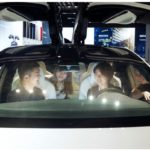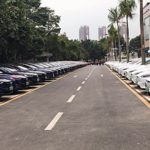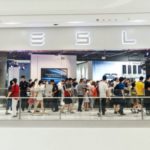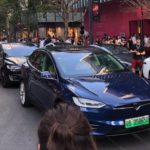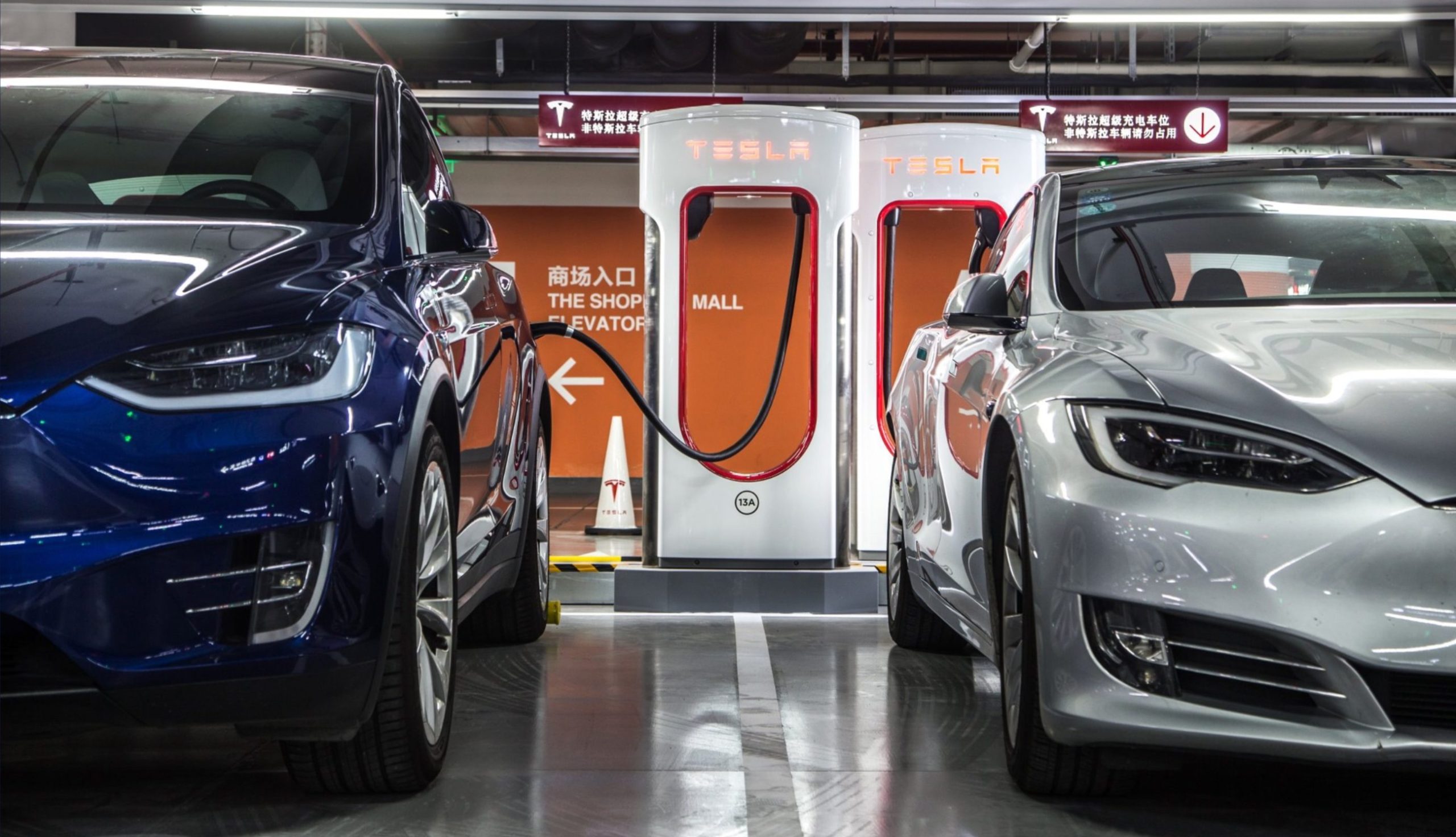
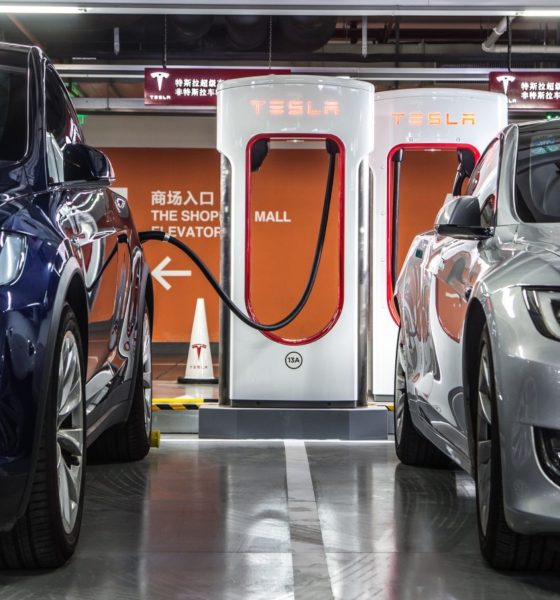
Investor's Corner
Tesla’s China factory can’t arrive soon enough amid escalating US-China trade war
Amidst the escalating trade war between the United States and China, American automakers such as Tesla have become the first victims of renewed, hefty tariffs on US-made products entering the country. In response to the 25% duties imposed by the United States government on $34 billion worth of Chinese imports last week, China has decided to strike back by placing a 40% levy on vehicles made in America.
The latest tariffs have forced Tesla to raise the prices of its Model S luxury sedan and its Model X SUV by 150,000 yuan ($22,647) to 250,000 yuan ($37,744). With the new duties in place, a fully-loaded Tesla Model S P100D now costs 1.47 million yuan ($221,937) in China, a far cry from the $147,000 price of the vehicle in the United States.
The latest tariffs come at a time when China implemented a reduction of its import duties for foreign-made vehicles from 20-25% to 15%. On the heels of the Chinese government’s announcement earlier this year, the response from Tesla’s customer base in the country was immediate. In Tesla’s Shanghai gallery alone, prospective buyers cleared out the store’s entire Model X 75D inventory in 24 hours after it was announced that the price of the vehicle would be reduced by $11,000 after the 15% tariffs were implemented.
While it is unfortunate to see the ongoing trade dispute between the United States and China once more affecting the prices of Tesla’s vehicles in the country, it is pertinent to note that even with hefty taxes placed on its electric cars, Tesla was fighting the good fight in China, and it was still thriving. The company, after all, established its presence and its reputation under an environment where its cars were priced far beyond its local competition.
Tesla’s story in China is one that showcases the learning curve that the California-based electric car and energy company continues to go through. Tesla began taking pre-orders for the Model S in China in August 2013. At that point in Tesla’s history, CEO Elon Musk was not even sure how much the production vehicle would cost. Deliveries were also expected to be eight months away. Anticipation among Chinese buyers, however, were high nonetheless, thanks to a combination of factors including Elon Musk’s rockstar status, as well as talks about the vehicle’s performance and supercar-worthy acceleration. Pre-orders for the Model S topped 5,000 that year.
Unfortunately, Tesla was not able to support these first Model S owners properly. Due to miscalculations on its business strategy, Tesla ended up with a lot of disgruntled Chinese owners. One Model S buyer even made national news after he smashed the windshield of his own Tesla after the car arrived months later than expected. To top it off, the Supercharger network, widely considered as Tesla’s ace in the electric car industry today, was still in its infancy then, and China only had a small system centered around key cities. Things changed, however, on January 2015, when Elon Musk flew to China and met with President Xi Jinping. Musk also admitted to Tesla’s “earlier mistakes,” stating that he was nonetheless “very optimistic” about the company’s chances in the country. Tesla also attended the Shanghai Auto Show, sparking more interest in its electric vehicles.
- Tesla’s grand opening of its Changsha, China store. [Credit: @vincent13031925/Twitter]
- Credit: Dennis Chang via Twitter
- Tesla’s grand opening of its Changsha, China store. [Credit: @vincent13031925/Twitter]
- Tesla’s grand opening of its Shenzhen, China store. [Credit: @vincent13031925/Twitter]
In the months that followed, Tesla expanded its Supercharger network, curbing the “range anxiety” of China’s electric car owners. Word-of-mouth about the company’s non-dealership sales model also started spreading. Tesla’s business in China experienced a massive boost when it introduced the Model X as well, considering the country’s obsession with SUVs. Government regulations, such as Shanghai’s electric-car friendly license plates gave even more benefits to Tesla. By the end of 2017, Tesla had already opened the largest Supercharger in the world in Shanghai. The company’s sales in the country in 2016 also helped boost its revenue enough to join the Fortune 500 list for the first time.
With Tesla’s history in mind, the renewed tariffs from the United States and China’s ongoing trade dispute could actually have little effect on Tesla’s overall operations in the country. The new duties will result in lost sales — that much is a given — but Tesla’s pedigree as a luxury automaker that makes cars that are the ultimate status symbols in China remain undaunted.

Tesla’s approval for its China site from the Central Committee of the Communist Party of China. [Credit: vincent13031925/Twitter]
Tesla, after all, has not really started its mass market push in China. The Model 3 and the Model Y, the company’s two vehicles that are targeted to dominate in the midrange segment, have not arrived in the country as of yet. With Elon Musk confirming during the Q1 2018 earnings call that the next Gigafactory will be in China, and that the facility will incorporate vehicle production, the solely-owned factory should allow Tesla to avoid the import taxes imposed on its upcoming, more budget-friendly vehicles — trade war or no trade war.
Tesla’s China Gigafactory is expected to be the site where the electric car maker will manufacture the Model Y crossover SUV, as well as some of the Model 3. Both vehicles are targeted towards the mass-market, with Tesla estimating that the Model Y could see a demand of up to 1 million vehicles per year. With the Model Y and Model 3, Tesla could compete in China not only in the luxury segment, but on the more lucrative and more competitive midrange market as well. For now, however, Tesla’s efforts to establish its own factory in China seems to be going well, with the company being granted a final approval for its solely-owned electric car facility by the Central Committee of the Communist Party of China.

Investor's Corner
Tesla stock closes at all-time high on heels of Robotaxi progress

Tesla stock (NASDAQ: TSLA) closed at an all-time high on Tuesday, jumping over 3 percent during the day and finishing at $489.88.
The price beats the previous record close, which was $479.86.
Shares have had a crazy year, dipping more than 40 percent from the start of the year. The stock then started to recover once again around late April, when its price started to climb back up from the low $200 level.
This week, Tesla started to climb toward its highest levels ever, as it was revealed on Sunday that the company was testing driverless Robotaxis in Austin. The spike in value pushed the company’s valuation to $1.63 trillion.
Tesla Robotaxi goes driverless as Musk confirms Safety Monitor removal testing
It is the seventh-most valuable company on the market currently, trailing Nvidia, Apple, Alphabet (Google), Microsoft, Amazon, and Meta.
Shares closed up $14.57 today, up over 3 percent.
The stock has gone through a lot this year, as previously mentioned. Shares tumbled in Q1 due to CEO Elon Musk’s involvement with the Department of Government Efficiency (DOGE), which pulled his attention away from his companies and left a major overhang on their valuations.
However, things started to rebound halfway through the year, and as the government started to phase out the $7,500 tax credit, demand spiked as consumers tried to take advantage of it.
Q3 deliveries were the highest in company history, and Tesla responded to the loss of the tax credit with the launch of the Model 3 and Model Y Standard.
Additionally, analysts have announced high expectations this week for the company on Wall Street as Robotaxi continues to be the focus. With autonomy within Tesla’s sights, things are moving in the direction of Robotaxi being a major catalyst for growth on the Street in the coming year.
Elon Musk
Tesla needs to come through on this one Robotaxi metric, analyst says
“We think the key focus from here will be how fast Tesla can scale driverless operations (including if Tesla’s approach to software/hardware allows it to scale significantly faster than competitors, as the company has argued), and on profitability.”

Tesla needs to come through on this one Robotaxi metric, Mark Delaney of Goldman Sachs says.
Tesla is in the process of rolling out its Robotaxi platform to areas outside of Austin and the California Bay Area. It has plans to launch in five additional cities, including Houston, Dallas, Miami, Las Vegas, and Phoenix.
However, the company’s expansion is not what the focus needs to be, according to Delaney. It’s the speed of deployment.
The analyst said:
“We think the key focus from here will be how fast Tesla can scale driverless operations (including if Tesla’s approach to software/hardware allows it to scale significantly faster than competitors, as the company has argued), and on profitability.”
Profitability will come as the Robotaxi fleet expands. Making that money will be dependent on when Tesla can initiate rides in more areas, giving more customers access to the program.
There are some additional things that the company needs to make happen ahead of the major Robotaxi expansion, one of those things is launching driverless rides in Austin, the first city in which it launched the program.
This week, Tesla started testing driverless Robotaxi rides in Austin, as two different Model Y units were spotted with no occupants, a huge step in the company’s plans for the ride-sharing platform.
Tesla Robotaxi goes driverless as Musk confirms Safety Monitor removal testing
CEO Elon Musk has been hoping to remove Safety Monitors from Robotaxis in Austin for several months, first mentioning the plan to have them out by the end of 2025 in September. He confirmed on Sunday that Tesla had officially removed vehicle occupants and started testing truly unsupervised rides.
Although Safety Monitors in Austin have been sitting in the passenger’s seat, they have still had the ability to override things in case of an emergency. After all, the ultimate goal was safety and avoiding any accidents or injuries.
Goldman Sachs reiterated its ‘Neutral’ rating and its $400 price target. Delaney said, “Tesla is making progress with its autonomous technology,” and recent developments make it evident that this is true.
Investor's Corner
Tesla gets bold Robotaxi prediction from Wall Street firm
Last week, Andrew Percoco took over Tesla analysis for Morgan Stanley from Adam Jonas, who covered the stock for years. Percoco seems to be less optimistic and bullish on Tesla shares, while still being fair and balanced in his analysis.

Tesla (NASDAQ: TSLA) received a bold Robotaxi prediction from Morgan Stanley, which anticipates a dramatic increase in the size of the company’s autonomous ride-hailing suite in the coming years.
Last week, Andrew Percoco took over Tesla analysis for Morgan Stanley from Adam Jonas, who covered the stock for years. Percoco seems to be less optimistic and bullish on Tesla shares, while still being fair and balanced in his analysis.
Percoco dug into the Robotaxi fleet and its expansion in the coming years in his latest note, released on Tuesday. The firm expects Tesla to increase the Robotaxi fleet size to 1,000 vehicles in 2026. However, that’s small-scale compared to what they expect from Tesla in a decade.
Tesla expands Robotaxi app access once again, this time on a global scale
By 2035, Morgan Stanley believes there will be one million Robotaxis on the road across multiple cities, a major jump and a considerable fleet size. We assume this means the fleet of vehicles Tesla will operate internally, and not including passenger-owned vehicles that could be added through software updates.
He also listed three specific catalysts that investors should pay attention to, as these will represent the company being on track to achieve its Robotaxi dreams:
- Opening Robotaxi to the public without a Safety Monitor. Timing is unclear, but it appears that Tesla is getting closer by the day.
- Improvement in safety metrics without the Safety Monitor. Tesla’s ability to improve its safety metrics as it scales miles driven without the Safety Monitor is imperative as it looks to scale in new states and cities in 2026.
- Cybercab start of production, targeted for April 2026. Tesla’s Cybercab is a purpose-built vehicle (no steering wheel or pedals, only two seats) that is expected to be produced through its state-of-the-art unboxed manufacturing process, offering further cost reductions and thus accelerating adoption over time.
Robotaxi stands to be one of Tesla’s most significant revenue contributors, especially as the company plans to continue expanding its ride-hailing service across the world in the coming years.
Its current deployment strategy is controlled and conservative to avoid any drastic and potentially program-ruining incidents.
So far, the program, which is active in Austin and the California Bay Area, has been widely successful.
